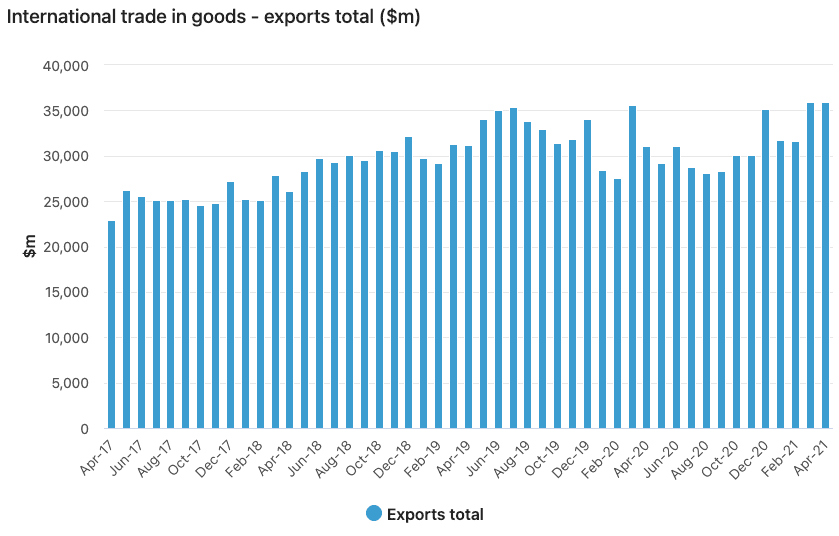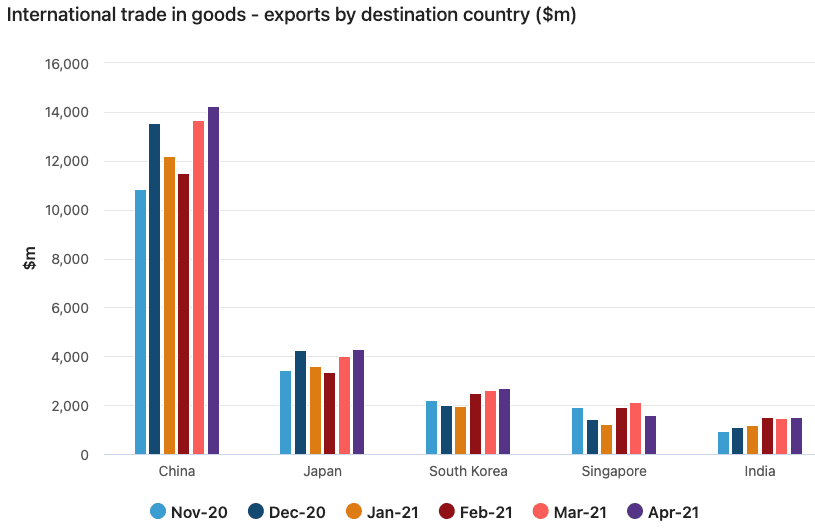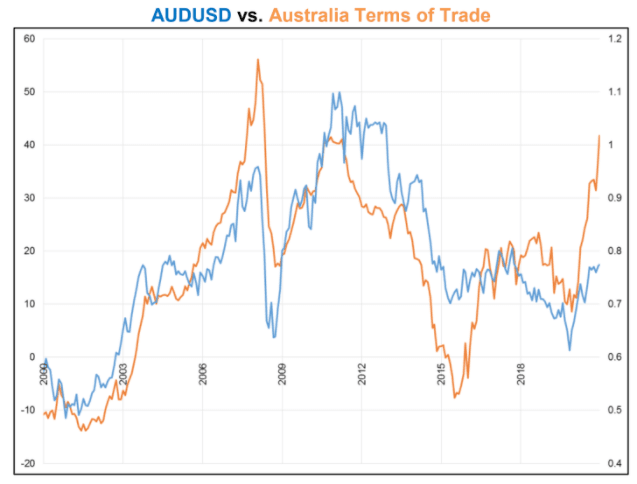Australian Dollar Forecast to Retain Support thanks to Record Trade Surplus with China
- Written by: Gary Howes

Image © Adobe Images
- GBP/AUD reference rates at publication:
- Spot: 1.8177
- Bank transfer rates (indicative guide): 1.7540-1.7670
- Money transfer specialist rates (indicative): 1.714-1.8050
- More information on securing specialist rates, here
- Set up an exchange rate alert, here
While the Australian Dollar might have been left behind by booming commodity prices, it is unlikely to suffer any major decline, particularly if the country's latest trade data is anything to go by.
The preliminary set of Australian International Merchandise Trade data for April showed the exports of goods increased A$13MN to A$35,952MN in April 2021, while the imports of goods in April 2021 declined A$1,896MN (-7%) to A$25,811MN.
This means for April 2021 Australia experienced a goods trade surplus of A$10,141MN, according to the Australian Bureau of Statistics.
The April data meant exports rose by 16% on a year-on-year basis, which is a new record.
"Beyond the vagaries of equity markets, the AUD may also have been helped by preliminary trade data for April," says Daragh Maher, Head of Research for the Americas at HSBC, commenting on movements in the Australian Dollar in the wake of the data release.
Image courtesy of the ABS
Secure a retail exchange rate that is between 3-5% stronger than offered by leading banks, learn more.
Despite ongoing political and trade tensions with China, Australia's exports to the world's second-largest economy actually rose to a new record of A$14.3BN in the month.
Ore exports reached a record high (A$16,468MN) for the second month in a row.
The developments underscore the significance of raw material trade between China and Australia and why the Australian Dollar is classed as a 'commodity currency' in financial circles.
"Australia being a major commodities exporter, rallies in Iron ore and Copper price tends to support AUD flows," says Paul Robson, Head of G10 FX Strategy at NatWest Markets.
Exports to China increased A$591MN (4%), exports to Japan increased A$297MN (7%), exports to South Korea increased A$118MN (5%) and exports to India increased A$23m (2%).
Trade data matters for currencies as those countries that export more than they import are likely to receive positive capital inflows.
Of course a currency's value is derived from numerous factors, but a consistent positive trade balance is widely held by economists to be supportive factor.
Image courtesy of the ABS
"The resilient commodity cycle is one of several fundamental drivers" that can yet send the Australian Dollar higher says Robson.
The Australian Dollar has however failed to match up to expectations of late with currency analysts saying it has been left behind by the boom in global commodity prices.
In the last major commodity 'super cycle' of the early 2010's the Australian Dollar was lifted to record valuations, but with iron ore prices breaking previous records it has come as a surprise to some that the Aussie Dollar has not delivered its own new records.
"The conversation around AUD here on the desk has mostly revolved around how poorly it trades in what is pretty much a commodity supercycle. The chart below shows AUDUSD vs. Australian Terms of Trade since 2000. As you can see, the terms of trade is back to 2007 or 2011 levels while the currency continues to languish," said Brent Donnelly, Senior FX Dealer with HSBC in New York, in a note out last week.
Image courtesy of HSBC.
Nevertheless trade dynamics still remain supportive, even if they are not propelling the Australian Dollar to dizzying new heights and some analysts say the currency can ultimately continue trending higher and close the undervaluation gap.
"Despite political spats with China over Australia's call for a meaningful probe into the origins of Covid-19, "AUD’s performance has held up well, thanks to the rise in Industrial commodity prices," says Natwest's Robson.
NatWest tell clients they continue to expect further gains in commodities backed by expectations of a weaker USD, supply disruptions and demand push due to a synchronised global growth recovery.
"This should further AUD gains," says Robson.
{wbamp-hide start} {wbamp-hide end}{wbamp-show start}{wbamp-show end}







